Introduction
The cottonwood leaf beetle, Chrysomela scripta Fabricius, is one of the most economically-important pests of managed cottonwood, aspen, and some poplar and willow species. Although it does not present a serious pest problem in forests, often it is a severe pest of urban ornamental trees. This leaf feeder has several generations each year, may cause extensive leaf loss, and can consequently reduce stem volume up to 70% (Coyle et al., 2005).
Cottonwood, Populus deltoides, is its primary host. As soon as spring leaf growth occurs, the cottonwood leaf beetle moves from under the bark, litter, or forest debris to the host trees to feed on the leaves and twigs. The beetle feeds most often on immature buds. Leaf beetles can complete their entire holometabolous life cycle on cottonwood if food is available (Smith and Ward 1998).

Credit: Lacy Hyche, Auburn University; www.insectimages.org
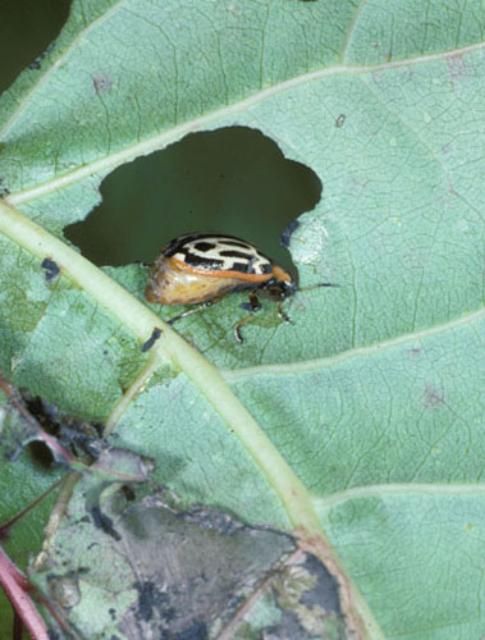
Credit: Lacy Hyche, Auburn University; www.insectimages.org
Distribution
Cottonwood leaf beetle is a native pest that occurs throughout the United States, including Alaska, in areas where cottonwood, poplar and willow exist (Krischiks 2007). The beetle severely attacks willow, aspens, and alders in the eastern half of the US (Laforest 2010).
Cottonwood leaf beetle has been reported to attack plantations of willows and cottonwoods in southeast Alaska, especially in the summer. However, it is also known to occur throughout the south-central and interior of Alaska. Additional Chrysomela species are common in the northern and western US.
Description
Adults
The adult beetles are 6 mm (1/4 inch) long with a black head and thorax and clavate antenna. They also possess yellow or reddish margins on the thorax. However, the orange patterns vary among the adults. The elytra are yellowish with broken black stripes. In most cases, the male is considerably smaller than the female.
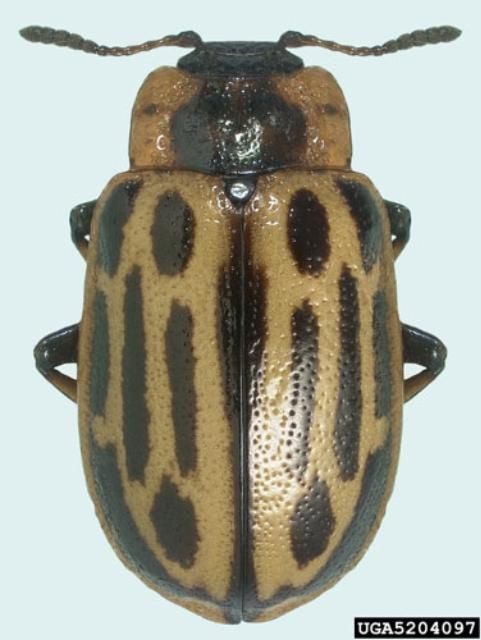
Credit: Natasha Wright, Florida Department of Agriculture and Consumer Services; www.insectimages.org
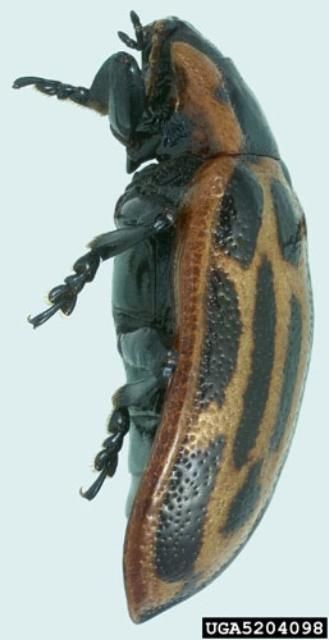
Credit: Natasha Wright, Florida Department of Agriculture and Consumer Services; www.insectimages.org
Eggs
The yellow, lemon-like eggs are laid in clusters of 15–75 on the underside of the foliage.
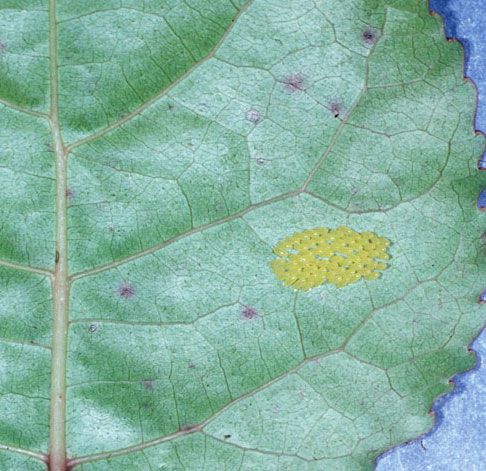
Credit: Lacy Hyche, Auburn University; www.insectimages.org
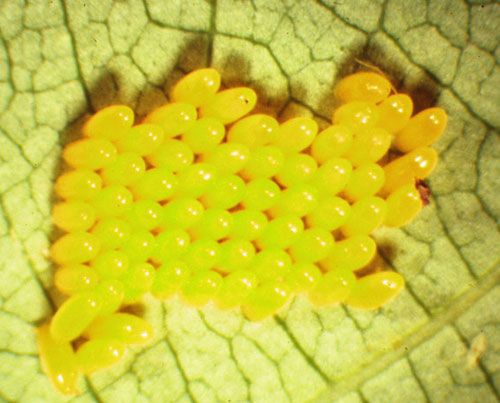
Credit: Dennis Haugen; www.insectimages.org
Larvae
The young larvae are black in color, but will eventually become light to dark brown with noticeable white scent glands as spots along their body. In many instances, young larvae begin their feeding gregariously on the underside of the foliage. Older larvae feed singularly and usually consume the entire leaf, except for the thicker veins. However, they vary in color, often are gray, and may grow to 12 mm in length (Smith and Ward 1998).
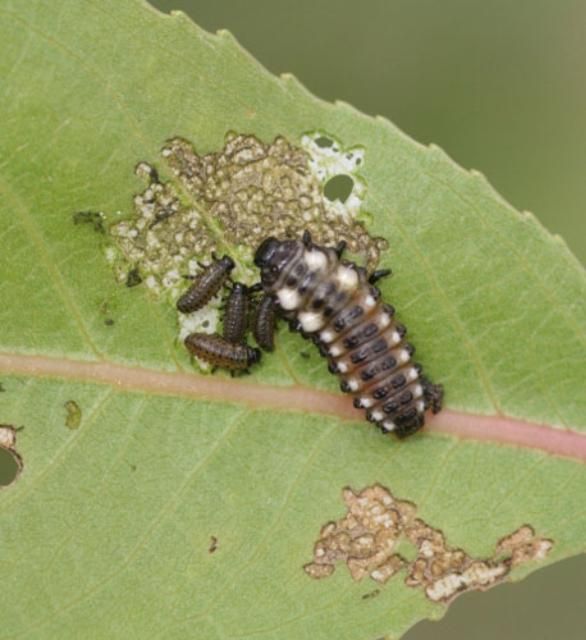
Credit: Whitney Cranshaw, Colorado State University; www.insectimages.org
Pupae
The pupae resemble the larvae, being black in color. Pupae are found on branches and leaves.
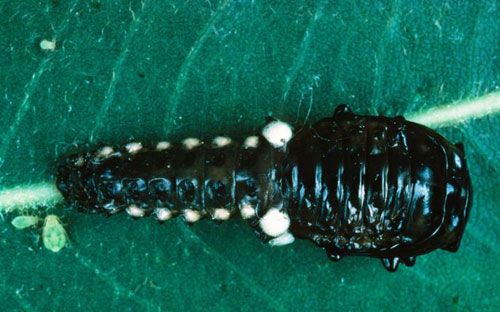
Credit: Gerald J. Lenhard, Louisiana State University; www.insectimages.org

Credit: Lacy Hyche, Auburn University; www.insectimages.org
Life Cycle and Biology
Cottonwood leaf beetles overwinter as adults. They have been reported to emerge from under the bark of trees, leaf litter and forest debris. Adult beetles can often be easily collected in large numbers under or close to cottonwood or willow.
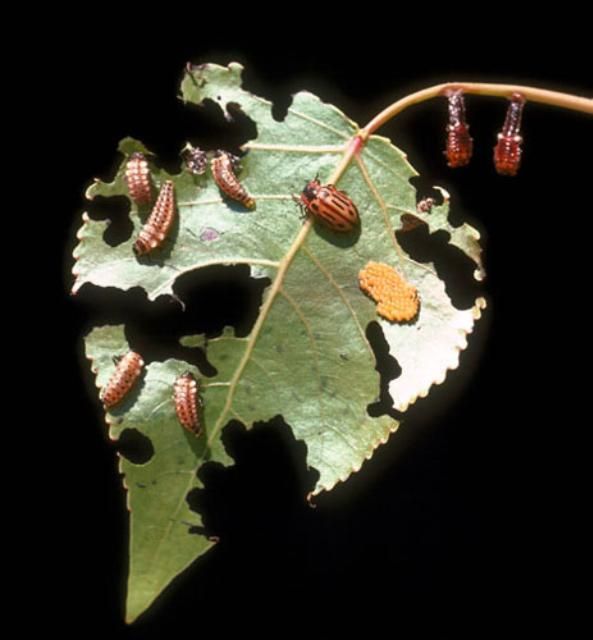
Credit: James Solomon, USDA Forest Service; www.insectimages.org
As host plants initiate leaf formation and expansion in the spring, the beetles feed on the unfolded leaves and tender buds at the tips of the twigs. Shortly after mating occurs, females begin ovipositing yellow lemon-like eggs in clusters of 25 or more. Eggs hatch after one or two weeks and a black larva emerges. The larvae survive by feeding gregariously and skeletonizing the leaves.
Early stage larvae are not readily susceptible to predation due to their repellent defenses (Krischiks 2007). The larvae emit a pungent odor from the scent glands when disturbed. Interestingly, the scent droplet is reabsorbed by the larvae after danger has passed. Mature larvae also possess this same defensive ability.
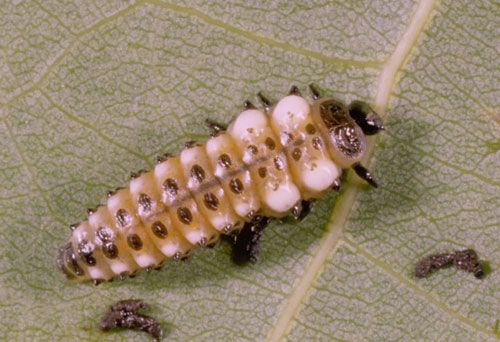
Credit: Gerald J. Lenhard, Louisiana State University; www.insectimages.org
As larvae mature, they become lighter in color and reach the pupal stage after one or two weeks of feeding. The mature larvae attach in an upside down position to the underneath leaves and bark of their hosts or on weeds to initiate pupation. After five to 10 days of pupation, the first generation of adults appears. The number of generations varies according to latitude and climate (Krischiks 2007).
Hosts
Chrysomela scripta is a very serious defoliator of many plantation grown Populus spp. especially poplar, aspen, alder, and cottonwood. The beetle is reported to feed on leaves of basket willow, Salix viminalis.
Plant Damage
Chrysomela scripta is the most serious defoliator of young Populus spp. The aggregated larvae skeletonize the underside of the leaves before later separating and consuming all but the large leaf veins. When the adult feeds on the leaf it forms holes and in some cases consumes the leaf entirely. The photosynthetic area is reduced and the plant cannot process food. In commercial nurseries, defoliation causes secondary problems when trees are attacked in the early stages. For example, lateral buds sprout below the injured terminal which consequently causes multiple forked tops and loss of marketable qualities.
Also, in other hosts, especially cottonwoods, cottonwood leaf beetles cause severe damage within the first three years of growth. Defoliation can decrease diameter and height of the trees and increases lateral branching and terminal forking (Smith and Ward 1998).
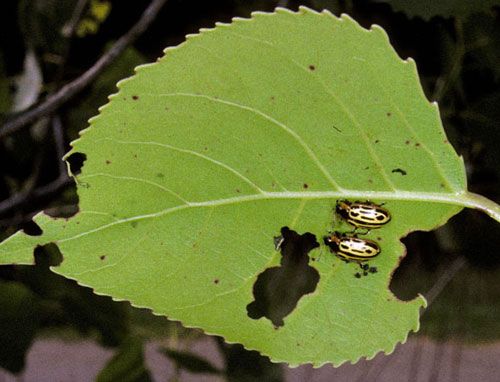
Credit: Andrew J. Boone, South Carolina Forestry Commission; www.insectimages.org
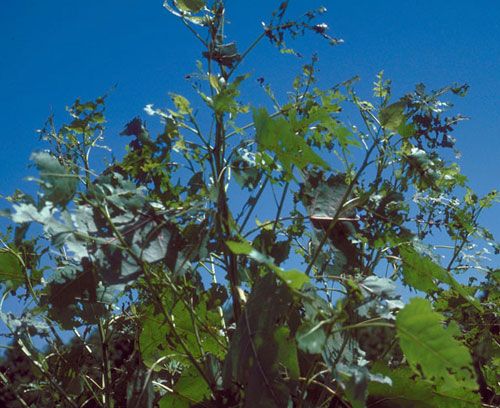
Credit: James Solomon, USDA Forest Service; www.insectimages.org
Management
Cultural Control
Weed management is a basic agronomic practice that can help suppress this pest. This should be done before winter to reduce cottonwood leaf beetle adult survival. The use of commercial varieties that are resistant to defoliation is critical.
Biological Control
There have been reports of natural enemies that attack cottonwood leaf beetle. These include the stink bug, Stiretus anchorago; the convergent lady beetle, Hippodamia convergens; v-marked lady beetle, Neoharmonia venusta; as well as ants, spiders and parasitic wasps. The convergent lady beetle feeds on the eggs while stink bugs attack the adult beetles. The microbial insecticide Bacillus thuringiensis strains "San Diego" and "tenebrionis" have been used as a preventative and curative method to control cottonwood leaf beetle adults.
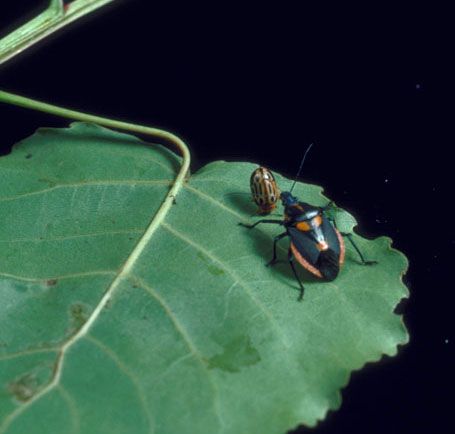
Credit: Lawrence Abrahamson, State University of New York; www.insectimages.org
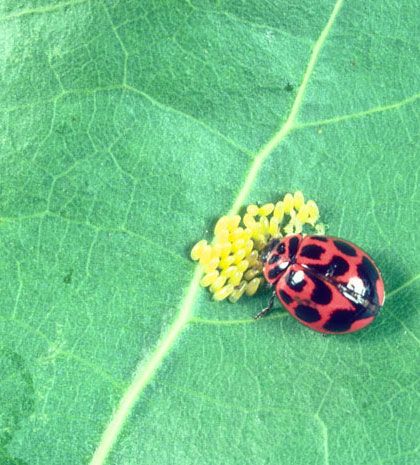
Credit: James Solomon, USDA Forest Service; www.insectimages.org
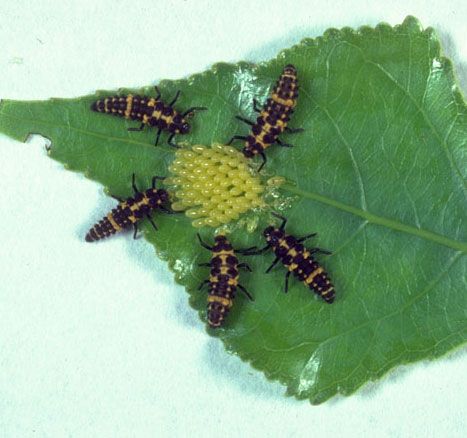
Credit: James Solomon, USDA Forest Service; www.insectimages.org
Chemical Control
Cottonwood leaf beetles are mainly managed using chemical insecticides. Interestingly, azadirachtin (from neem), a botanical pesticide that belongs to the tetranortriterpenoid family, provides good suppression (Cordero et al. 2003).
Selected References
Cordero J, Boshier D, Barrance A. 2003. Arboles de Centroamerica: un manual para extensionistas. Orton IICA/CATIE. 1079 pp.
Coyle D, McMillan J, Hall R, Hart E. 2001. Cottonwood leaf beetle (Coleoptera; Chrysomelidae) larval performance on eight populus clones. Environmental Ecology 30: 748-756.
Johnson WT, Lyon HH. 1991. Insects That Feed on Trees and Shrubs, 2nd edition. Cornell University Press. 560 pp.
Krischiks V. (February 2007). Cottonwood Leaf Beetle. Center for Urban Ecology and Sustainability. http://www.entomology.umn.edu/cues/cwlb/index.html (February 2012).
LaForest J. (September 2010). Cottonwood leaf beetle (Chrysomela scripta). BugwoodWiki. https://wiki.bugwood.org/Archive:South/Chrysomela_scripta (February 2016).
Smith R, Ward C. (September 1998). Chrysomela scripta F. New Mexico State University. http://aces.nmsu.edu/pubs/_circulars/circ552.html (February 2016).